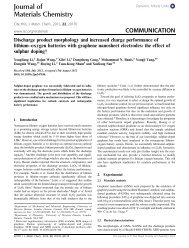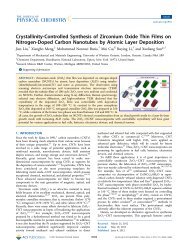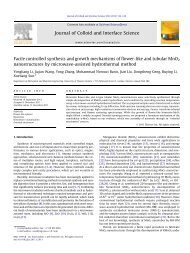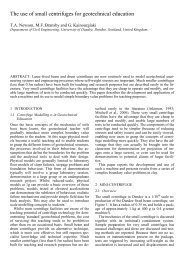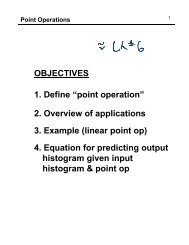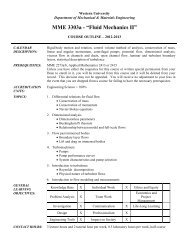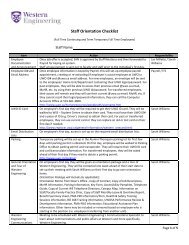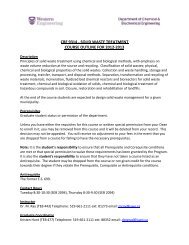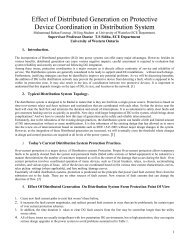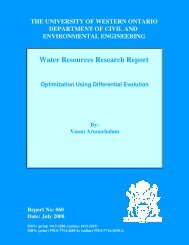Physical Modelling of the Upheaval Resistance of Buried Offshore ...
Physical Modelling of the Upheaval Resistance of Buried Offshore ...
Physical Modelling of the Upheaval Resistance of Buried Offshore ...
You also want an ePaper? Increase the reach of your titles
YUMPU automatically turns print PDFs into web optimized ePapers that Google loves.
Stolt <strong>Offshore</strong> sponsored <strong>the</strong> University <strong>of</strong><br />
Dundee to undertake a research project to improve<br />
understanding <strong>of</strong> <strong>the</strong> failure mechanisms associated<br />
with pipeline uplift and <strong>the</strong> monotonic uplift<br />
resistance. This paper reports some <strong>of</strong> <strong>the</strong> model<br />
tests carried out for drained loading conditions.<br />
2 EXPERIMENTAL METHOD<br />
2.1 Test geometry<br />
Model testing was carried out both in <strong>the</strong> laboratory<br />
(at 1g) and in a 5g acceleration field in <strong>the</strong> Dundee<br />
Geotechnical centrifuge. Both series <strong>of</strong> tests<br />
consisted <strong>of</strong> <strong>the</strong> extraction <strong>of</strong> a 500 mm length <strong>of</strong><br />
pipe from a box <strong>of</strong> soil with continuous<br />
measurement <strong>of</strong> force and pipe displacement.<br />
Because both geometries modelled plane strain<br />
conditions and both pipes were rigid; results are<br />
presented later per unit length <strong>of</strong> pipe. The front face<br />
<strong>of</strong> <strong>the</strong> soil boxes were perspex and <strong>the</strong> pipe was<br />
positioned perpendicular to <strong>the</strong> perspex front face,<br />
allowing <strong>the</strong> soil (and pipe) to be observed as pullout<br />
progressed.<br />
Pipes <strong>of</strong> 32 mm and 48 mm outside diameter and<br />
length <strong>of</strong> 495 mm were tested in <strong>the</strong> laboratory,<br />
whilst pipes <strong>of</strong> diameter 48 mm and length 498 mm<br />
were tested at 5g (and 5.2g) in <strong>the</strong> geotechnical<br />
centrifuge. Scaling laws (as reported by Sch<strong>of</strong>ield,<br />
1980) ensured that <strong>the</strong> 48 mm pipe at 5g would<br />
behave as a prototype 5 times larger (i.e.<br />
D=5x48mm= 240 mm).<br />
2.2 Laboratory and centrifuge testing<br />
methodology<br />
The preparation procedures were <strong>the</strong> same for both<br />
types <strong>of</strong> tests. Sand was placed to a depth <strong>of</strong> 30-50<br />
mm in <strong>the</strong> base <strong>of</strong> <strong>the</strong> box and <strong>the</strong> pipe was<br />
positioned on <strong>the</strong> surface <strong>of</strong> <strong>the</strong> soil. The pipe was<br />
located with its ends almost in contact with <strong>the</strong> front<br />
and back perspex faces <strong>of</strong> <strong>the</strong> box (Figure 2a) and<br />
grease was pushed into <strong>the</strong> gap to prevent soil<br />
entering <strong>the</strong> gap between <strong>the</strong> pipe and <strong>the</strong> front face.<br />
Additional sand was <strong>the</strong>n added until <strong>the</strong> required<br />
pipe embedment depth was achieved. Whilst <strong>the</strong><br />
sand sample was being placed above <strong>the</strong> pipe, it was<br />
important that <strong>the</strong> pipe was free to settle vertically so<br />
that a net vertical load was not applied to <strong>the</strong> pipe<br />
before <strong>the</strong> pull-out test commenced. If this were not<br />
done, <strong>the</strong> mobilisation distance to peak load would<br />
be underestimated. During a number <strong>of</strong> <strong>the</strong> tests, a<br />
grid <strong>of</strong> black markers at approximately 50 mm<br />
centres were placed in <strong>the</strong> soil touching <strong>the</strong> perspex<br />
front face while <strong>the</strong> soil was being prepared. This<br />
allowed later photographic measurement <strong>of</strong> soil<br />
movements through <strong>the</strong> perspex front face (Figure<br />
2a).<br />
Figure 2. Testing apparatus - (a) <strong>the</strong> laboratory test<br />
apparatus (b) centrifuge model package<br />
The pipe was <strong>the</strong>n pulled out <strong>of</strong> <strong>the</strong> soil using a<br />
rigid hanger arrangement to ensure that <strong>the</strong> pipe<br />
moved with uniform displacement and vertically<br />
(Figure 2a, b). Load was measured using a load cell<br />
and displacement using a potentiometer or LVDT.<br />
This was done using an Instron device in <strong>the</strong><br />
laboratory or a specially designed actuator in <strong>the</strong><br />
centrifuge. For tests with <strong>the</strong> soil marker grids, a<br />
series <strong>of</strong> digital photographs or analogue video was<br />
taken <strong>of</strong> <strong>the</strong> front face <strong>of</strong> <strong>the</strong> box as <strong>the</strong> pipe moved<br />
towards <strong>the</strong> soil surface.<br />
Soil preparation varied depending on <strong>the</strong> required<br />
density and whe<strong>the</strong>r <strong>the</strong> soil was dry or saturated.<br />
High sand and gravel dry densities (close to ρmax)<br />
were achieved by layered compaction. Loose, dry<br />
sand was prepared by quick sand pouring. Loose,<br />
saturated sand samples were prepared by pluviating<br />
sand through air into 200 mm <strong>of</strong> water. A sand or<br />
gravel berm was constructed once <strong>the</strong> strongbox was<br />
placed on <strong>the</strong> centrifuge arm by pouring through a<br />
funnel onto <strong>the</strong> soil surface. This would have created<br />
an intermediate density berm.<br />
2.3 Programme <strong>of</strong> tests<br />
The tests reported in this paper were conducted on<br />
ei<strong>the</strong>r silica sand or gravel. The sand was uniformly<br />
graded with d50 = 0.3 mm, Gs = 2.65 and <strong>the</strong><br />
particles were subrounded. The angle <strong>of</strong> repose <strong>of</strong><br />
<strong>the</strong> loose soil was measured to be 32 o and this is<br />
believed to be close to <strong>the</strong> critical state angle <strong>of</strong><br />
friction, φcrit. The gravel was subangular with d50 = 5<br />
mm and had an angle <strong>of</strong> repose <strong>of</strong> 35 o .<br />
Model tests were conducted in loose sand in <strong>the</strong><br />
centrifuge and <strong>the</strong> laboratory. O<strong>the</strong>r variables<br />
investigated were <strong>the</strong> diameter <strong>of</strong> <strong>the</strong> pipe, its<br />
embedment ratio (H/D), whe<strong>the</strong>r <strong>the</strong> soil was dry or<br />
saturated and <strong>the</strong> presence <strong>of</strong> a berm. The series <strong>of</strong><br />
tests is summarised in Table 1.





